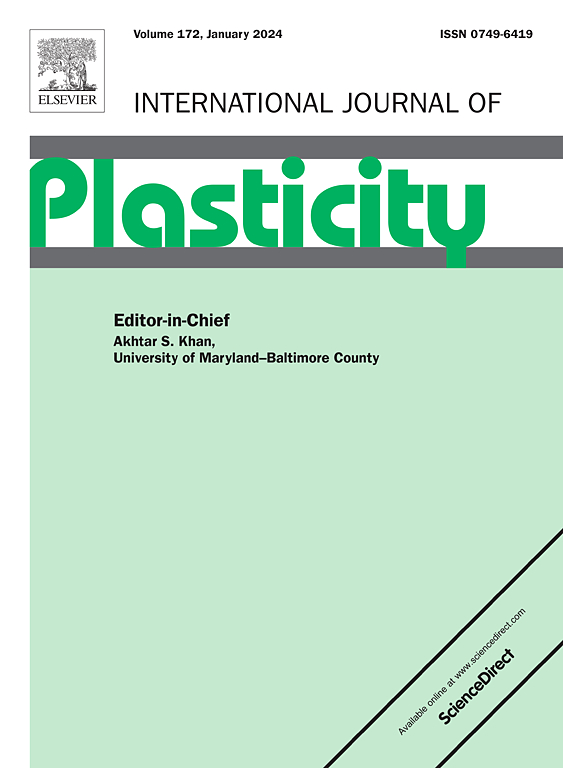用于预测金属薄板力学行为和延性极限的晶体塑性-损伤耦合有限元框架
IF 9.4
1区 材料科学
Q1 ENGINEERING, MECHANICAL
引用次数: 0
摘要
提出了一种新的晶体塑性有限元方法来预测金属薄板的力学行为和塑性极限。在这种方法中,选择具有代表性的体积元素(RVE)来准确捕获这些金属板的机械特性。该方法采用周期均匀化多尺度方案,保证了RVE和单晶尺度之间的转换。在单晶尺度上,力学行为被建模为有限应变框架下的弹塑性。塑性流动由修正版的施密德定律控制,该定律包含了损伤对微观力学变量演化的影响。利用连续损伤力学(CDM)的框架对损伤行为进行建模,在每个晶体滑移系统(CSS)的水平上引入标量微观损伤变量。该损伤变量的演化规律来源于热力学力,导致微观塑性流动偏离正态性规律。这种损伤和弹塑性行为的耦合导致了一组高度非线性的本构方程。为了求解这些方程,开发了一种有效的回归映射算法,并通过用户定义的材料子程序(UMAT)在ABAQUS/Standard有限元软件中实现。在宏观尺度上,用Rice分岔理论预测了局部缩颈的发生。通过数值模拟验证了所提出的损伤耦合单晶模型及其积分方案。分析广泛探讨了微观结构和损伤参数对单晶和多晶聚集体力学行为和延性极限的影响。数值结果表明,细观损伤和偏离正常塑性流动规律对塑性行为和延性极限都有显著影响。本文章由计算机程序翻译,如有差异,请以英文原文为准。
A crystal plasticity-damage coupled finite element framework for predicting mechanical behavior and ductility limits of thin metal sheets
A new crystal plasticity finite element (CPFE) approach is developed to predict the mechanical behavior and ductility limits of thin metal sheets. Within this approach, a representative volume element (RVE) is chosen to accurately capture the mechanical characteristics of these metal sheets. This approach uses the periodic homogenization multiscale scheme to ensure the transition between the RVE and single crystal scales. At the single crystal scale, the mechanical behavior is modeled as elastoplastic within the finite strain framework. The plastic flow is governed by a modified version of the Schmid law, which incorporates the effects of damage on the evolution of microscopic mechanical variables. The damage behavior is modeled using the framework of Continuum Damage Mechanics (CDM), introducing a scalar microscopic damage variable at the level of each crystallographic slip system (CSS). The evolution law of this damage variable is derived from thermodynamic forces, resulting in deviations from the normality rule in microscopic plastic flow. This coupling of damage and elastoplastic behavior leads to a highly nonlinear set of constitutive equations. To solve these equations, an efficient return-mapping algorithm is developed and implemented in the ABAQUS/Standard finite element software via a user-defined material subroutine (UMAT). At the macroscopic scale, the onset of localized necking is predicted by the Rice bifurcation theory. The proposed damage-coupled single crystal model and its integration scheme are validated through several numerical simulations. The analysis extensively explores the impact of microstructural and damage parameters on the mechanical behavior and ductility limits of both single crystals and polycrystalline aggregates. The numerical results indicate that both of the mechanical behavior and ductility limits are significantly influenced by the microscopic damage and deviations from normal plastic flow rule.
求助全文
通过发布文献求助,成功后即可免费获取论文全文。
去求助
来源期刊

International Journal of Plasticity
工程技术-材料科学:综合
CiteScore
15.30
自引率
26.50%
发文量
256
审稿时长
46 days
期刊介绍:
International Journal of Plasticity aims to present original research encompassing all facets of plastic deformation, damage, and fracture behavior in both isotropic and anisotropic solids. This includes exploring the thermodynamics of plasticity and fracture, continuum theory, and macroscopic as well as microscopic phenomena.
Topics of interest span the plastic behavior of single crystals and polycrystalline metals, ceramics, rocks, soils, composites, nanocrystalline and microelectronics materials, shape memory alloys, ferroelectric ceramics, thin films, and polymers. Additionally, the journal covers plasticity aspects of failure and fracture mechanics. Contributions involving significant experimental, numerical, or theoretical advancements that enhance the understanding of the plastic behavior of solids are particularly valued. Papers addressing the modeling of finite nonlinear elastic deformation, bearing similarities to the modeling of plastic deformation, are also welcomed.
 求助内容:
求助内容: 应助结果提醒方式:
应助结果提醒方式:


